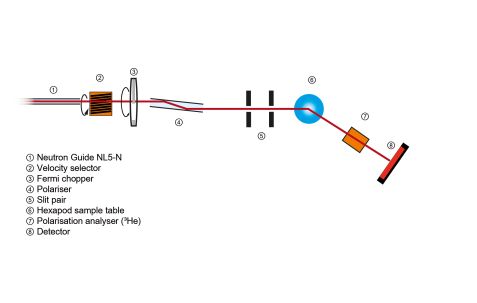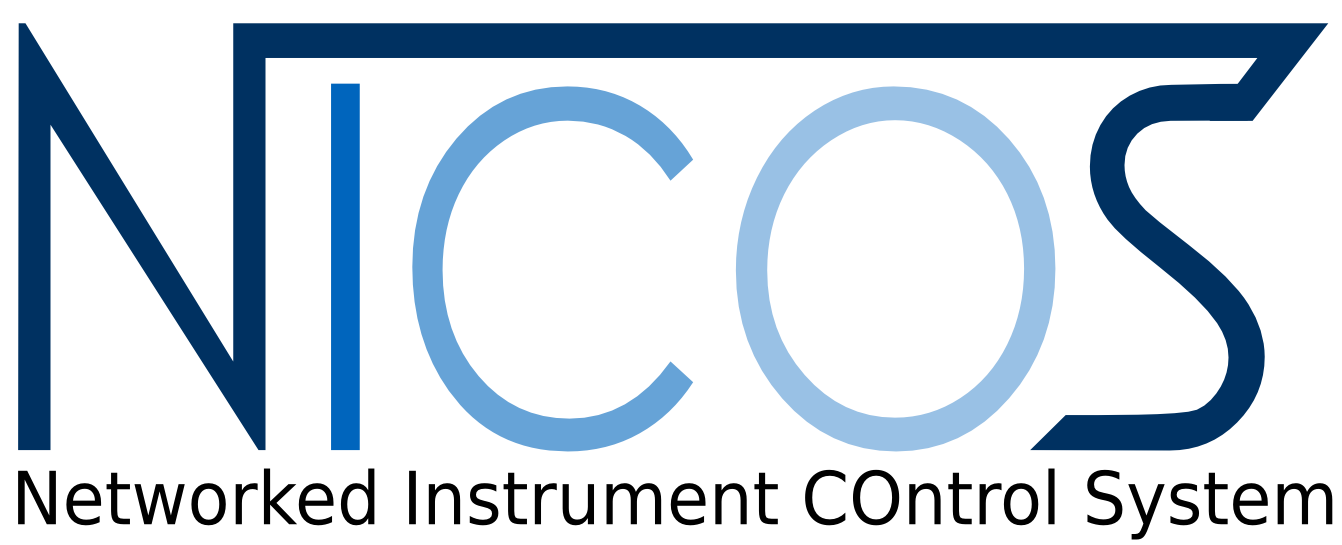MLZ is a cooperation between:
 > Technische Universität München
> Technische Universität München > Helmholtz-Zentrum Hereon
> Helmholtz-Zentrum Hereon
 > Forschungszentrum Jülich
> Forschungszentrum Jülich
MLZ is a member of:
 > LENS
> LENS > ERF-AISBL
> ERF-AISBL
MLZ on social media:

MLZ (eng)
Lichtenbergstr.1
85748 Garching
MARIA
Magnetic reflectometer with high incident angle
This instrument is focussed on cold neutrons. All parameters given here are valid during the current operation of FRM II. Please get in touch with the instrument team well in advance for all further details (length of experiment etc.).
The neutron reflectometer MARIA with polarisation analysis was designed for the investigation of thin magnetic layered structures down to the monolayer scale and lateral structures. The reflection of polarised neutrons allows to determine individually the density and the modulus and the direction of the magnetisation vector of buried layers.
MARIA is optimised for layer thicknesses between 3 – 300 Å and lateral structure sizes from nm to µm sizes. The instrument is working with a small focused beam and sample sizes of 1 cm2 at λ = 4.5 Å in a vertical orientation with a maximum incident angle of 180° and outgoing angle ranging from -14° to 100°. MARIA provides polarisation analysis in standard operation, where the beam is polarised by a polarising guide (z-geometry; and analyzed by a wide angle 3He-cell (or alternatively by a supermirror analyzer for only the specular beam providing registration of non-spinflip and spin-flip signal simultaneously).
Beside the above described reflectometer mode with good resolution in the horizontal scattering plane, MARIA can be used in the GISANS mode with additional resolution in the vertical direction. The latter mode allows for measuring lateral structures down to the nm scale.
With scattering under grazing incidence we investigate depth-resolved the laterally-averaged magnetizations and the correlations between their lateral fluctuations. With an additionally polarized neutron beam we derive a vector information on the laterally-averaged magnetization (reflectivity) and on the correlations between their lateral fluctuations (off-specular scattering – µm length scale, GISANS – nm length scale).
In general, MARIA can be used for measurements of magnetic roughness, the formation of magnetic domains in thin layered structures, lateral structures, etc. (polarised mode) and density profiles, structures of solid polymer layers, etc. (unpolarised mode with higher intensity).
Furthermore possible without the need for multilayers investigation of:
- Diluted semiconductors
- Influence of the substrate
- Interfaces between oxide materials
Additionally, the instrument in non-polarised beam mode can be used for reflectometry and GISANS studies of “soft” layers at the solid/ liquid interface by the use of appropriate liquid cells that are available at the beamline. Candidate systems for such investigations include polymer brushes, polyelectrolyte multilayers, biomimetic supported membranes, adsorbed proteins etc. For typical applications involving deuterated solvents the dynamic range that can be expected covers 6 orders of magnitude.
- Hexapod with additional turntable (360°) at sample position, max. load up to 500 kg
- Bruker electromagnet up to 1.3 T
- He closed cycle cryostat down to 4 K
Beside this standard setup the complete sample environment of the JCNS can be adopted to MARIA so that magnetic fields up to 5 T and temperatures from 50 mK to 500 K are available.
Furthermore, MARIA can provide users with a fully equipped Oxid-MBE. The typical sample sizes are 10 × 10 mm2 and as targets we can provide Al, Cr, Pr, Fe, La, Nb, Ag, Nd, Tb, Sr, Mn, Ti and Co.
All parts of MARIA are controlled by a computer system according to the “Jülich-Munich” standard based on a Linux workstation. This allows a flexible remote control with automatic scan programs, including the control of sample environment as cryostat and electromagnet.
- Neutron guide NL5-N:
- vertically focussing elliptic guide
- Monochromator: Velocity selector
- Wavelength:
- 4.5 Å – 10 Å (polarised)
- 4.5 Å – 40 Å (unpolarised)
- Resolution:
- 10 % velocity selector
- 1 %, 3 % Fermi chopper
- Double reflection polariser
- Horizontal scattering plane
- Expected pol. flux 5 · 106 n cm-2 s-1 for 3 mrad collimation
- 4100 mm distance S1 – S2 (collimation)
- 400 mm distance S2 – sample
- 50 mm × 40 mm (w × h) max. opening S2
- 1910 mm distance sample – detector
- 120° maximum detector angle
- GISANS option: 4 m collimation length
- Reflectometry:
- Qz- range 0.002 Å-1 – 3.2 Å-1
- Qx- range 6 · 10-5 Å-1 – 0.001 Å-1
- αf -14° – 100°
- GISANS option:
- Qy- range 0.002 Å-1 – 0.2 Å-1
- 3He cell (off-specular and GISANS)
- Supermirror analyzer (specular reflectivity)
Neutron Depth Profiling (NDP)
Alternatively to the reflectometer/GISANS mode MARIA can be operated with a multidetector Neutron Depth Profiling (NDP) setup using the focused beam. Neutron Depth Profiling allows the quantitative determination of the in-depth distribution for several light elements as 6Li, 10B, 14N and few others. In this instrument operation mode the NDPchamber is placed on the sample table, placing the NDP sample in the focal point of the vertically focusing elliptic neutron guide. The thermal equivalent neutron flux at the sample position amounts to 0.7 · 108 n cm-2 s-1. Combined with a multiple detector system for charged particle collection it gives the opportunity to perform fast, time-resolved NDPmeasurements with a depth resolution of 10 nm.
Different type of solid state Li-batteries and battery materials.
- Expected thermal equivalent flux 0.7 · 108 n cm-2 s-1 (10 × 20 mm2)
- Nominal limit of quantization for 6Li ~ 1013 at/cm2
- Energy resolution (alpha-particles) < 11 keV
Instrument Scientists
Dr. Alexandros Koutsioumpas
Phone: +49 (0)89 158860-674
E-Mail: a.koutsioumpas@fz-juelich.de
Dr. Sabine Pütter
Phone: +49 (0)89 158860-742
E-Mail: s.puetter@fz-juelich.de
MARIA
Phone: +49 (0)89 158860-514
Neutron Depth Profiling (NDP)
Dr. Egor Vezhlev
Phone: +49 (0)89 158860-654
E-Mail: e.vezhlev@fz-juelich.de
Operated by

Publications
Find the latest publications regarding MARIA in our publication database iMPULSE:
Citation of the instrument
Heinz Maier-Leibnitz Zentrum. (2015). MARIA: Magnetic reflectometer with high incident angle. Journal of large-scale research facilities, 1, A8. http://dx.doi.org/10.17815/jlsrf-1-29
For citation please always include the DOI.
Instrument control
Gallery


MLZ is a cooperation between:
 > Technische Universität München
> Technische Universität München > Helmholtz-Zentrum Hereon
> Helmholtz-Zentrum Hereon
 > Forschungszentrum Jülich
> Forschungszentrum Jülich
MLZ is a member of:
 > LENS
> LENS > ERF-AISBL
> ERF-AISBL
MLZ on social media:





